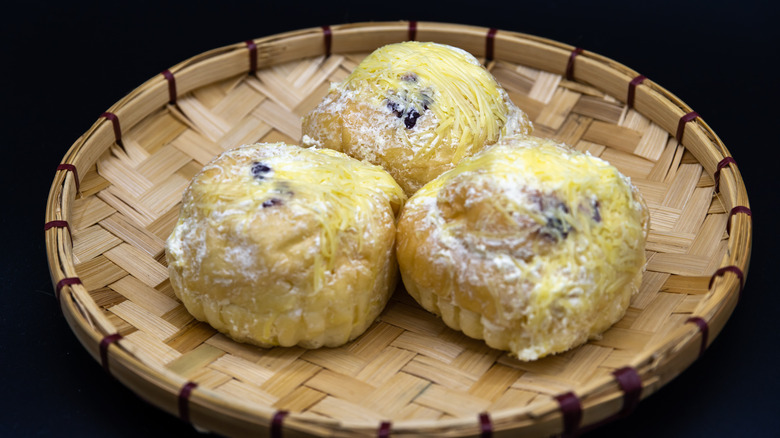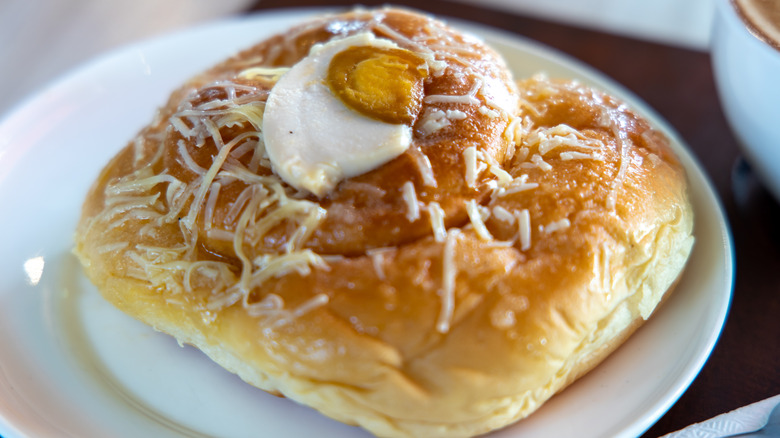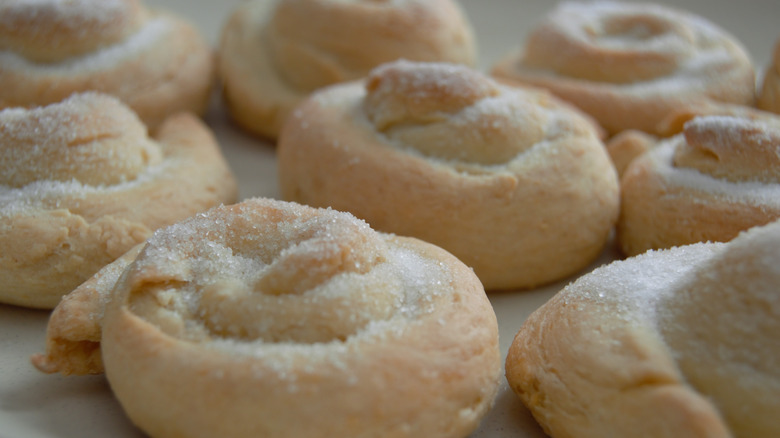Ensaymada: The Filipino Breakfast Staple You Need To Try
Nearly 7,000 miles separate Spain's Palma de Mallorca from the Philippines' historic capital, Manila. That's the distance Mallorca's local delicacy, the soft bun known as ensaimada, would have traveled to get to the Philippines by galleon centuries ago, where it eventually morphed to become ensaymada, one of the country's best-loved bakery treats, per Ang Sarap.
Given that the Philippines was a Spanish colony for more than 330 years, per the Embassy of the Philippines, it shouldn't come as a surprise that early versions of ensaimada that were first sold in the Philippines would have been similar to the one found in Mallorca today. Yummy refers to an ad that dates back to 1885 for a Manila bakeshop known as "Panaderia Y Pasteleria La Isla de Mallorca," which made "ensaimadas exactly the same as the best in Mallorca."
Mallorca's ensaimada hasn't changed; it continues to be made with bread flour, water, sugar, eggs, and a starter, kneaded into a rope onto which lard is then spread before it is coiled, per MallorcaWeb. But Filipino ensaymada recipes have evolved so that more egg yolks and fat is incorporated into the dough, making Philippine ensaymada what it is today.
There is more than one way to make a good ensaymada
While the Ensaimada de Mallorca bears the European Union's Protected Geographical Indication, which governs the ingredients that are used and the way it is made, there are no regulations that specify just how Philippine ensaymadas are made. This has resulted in something of a free-for-all, and different types of ensaymada can be found in different parts of the country.
Cookbook author Jenny Orillos tells Spot that while all ensaymada starts off with "the same basic ingredients with bread as its base. The formulation (amount), method (sponge and dough, straight dough), rolling technique, and topping may vary from baker to baker. The variation gives birth to the distinctive marks in the ensaymada."
Yummy says the ensaymada that is closest to its Mallorcan ancestor is the Manila-style ensaymada, whose recipes originated from the Spanish-style bakeries that dotted the historic section of the city known as Intramuros. Even in the 1920s, it is said that ensaymadas were dressed up with different add-ins that included "cheese, butter, ham, and sausage."
Another popular style, per Yummy, comes from the northern province of Pampanga. Pampanga ensaymadas are larger, golden yellow, filled with butter and topped with sugar and grated "queso de bola" or Edam cheese, per About Filipino Food.
A third type of ensaymada comes from Bulacan, which is topped with salted egg, per Yummy, or stuffed with ham, per recipe blogger JunBlog, who also compares the bun to brioche.
Different ensaymadas for different occasions
Ensaymadas are so popular they can be found in just about any bakery in the Philippines, alongside the perennial classics: pandesal, Spanish bread, and monay, per Ang Sarap. Ensaymadas today come in different forms and price points, so much so that they are available in corner bakery stores topped with margarine and sugar for less than 20 cents apiece, per Looking Four, to mouthwatering variations topped with butter, sugar, cheese, and — in some cases — a serving of ube tossed in, which will set you back anywhere from $2.50 to $8, per Spot. And in a nod to its roots, Pasterleria Mallorca, named after the pastry that started it all, even offers up an ensaymada baked from a centuries-old recipe. While the simpler, more humble ensaymadas will always have a place at the breakfast table, it is the more extravagantly dressed ensaymadas that are sought after when Christmas and Easter come around, per Yummy.
But at the end of the day, Orillos says it doesn't matter how the ensaymadas are dressed, it's the quality of the bread dough that counts. "[Filipinos think] the more toppings of cheese, butter and sugar, the better the ensaymada" because "If you take out all of these trimmings and you have lousy bread underneath, it kind of ruins the whole ensaymada experience," she says, per Spot. "The bread is the body and soul of the ensaymada."


